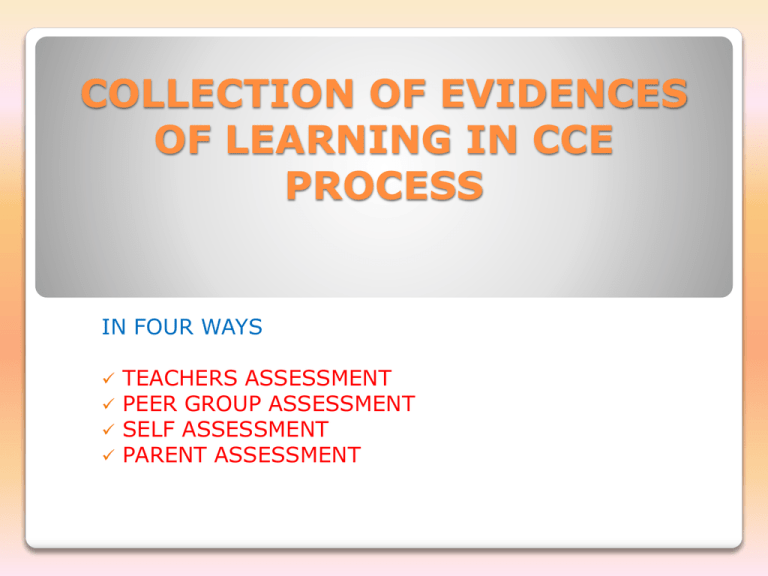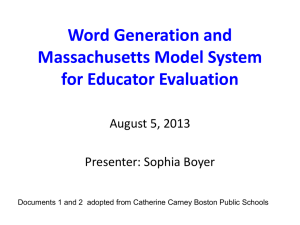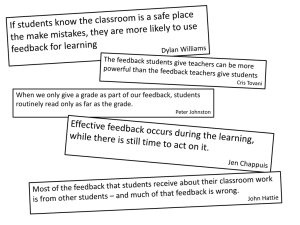COLLECTION OF EVIDENCES OF LEARNING IN CCE PROCESS
advertisement

COLLECTION OF EVIDENCES OF LEARNING IN CCE PROCESS IN FOUR WAYS TEACHERS ASSESSMENT PEER GROUP ASSESSMENT SELF ASSESSMENT PARENT ASSESSMENT TEACHER ASSESSMENT Competency Areas Performance Indicators Qualitative Recording Grading Recording In CCE Tools PEER GROUP ASSESSMENTE In Group Activities Choreography, Skit Other Group Products Group Presentations Peer Group Can Assess The Performance of Their Friends In The Group And The Performance of Their Group And Indicators. SELF ASSESSMENT I enjoyed reading the story. I could connect the idea in the story with the story my teacher told. I got the idea of the story from my own reading I got the idea with the help of my teacher and friends. PARENT ASSESSMENT How they perform in home . How they perform in community. Changes observed in leadership. Changes observed in enquiry skills. Changes observed in reading skills. Changes observed in arising doubts or questions. PTA meetings also. WHAT ARE THE PURPOSE OF ASSESSMENT ASSESSMENT FOR LEARNING. ASSESSMENT AS LEARNING. ASSESSMENT OF LEARNING. ASSESSMENT FOR LEARNING Assessment for learning is used to give teachers information to modify the teaching and learning activities in which students are engaged in order to differentiate and focus how individual students approach their learning. ASSESSMENT FOR LEARNING Intended to determine not only what student know ,but also gain insights into how , when and where students use what they know, so that they can streamline. Agent of judgment:-Teacher ,teacher and students together. It happens in the middle of learning often more than once not at the end. ASSESSMENT FOR LEARNING Learning activities in which assessment tasks are embedded . It is interactive with teachers providing assistance as part of the assessment. Use observation worksheets, units, questions, studentsteachers discussions etc. Detailed , student referenced task specific and locally developed indicators in the classroom. ASSESSMENT FOR LEARNING Comment or oral feedback, qualitative descriptions in evidences of learning compiled in students portfolios , It is to highlights each students strengths and weaknesses and provided them with feedback that will further their learning . It also shapes in the form of feedback toto scaffold next steps of learning. ASSESSMENT FOR LEARNING Teaching manual checklists of students progress against expectations , portfolios of students works over time and worksheets to trace the progression of students along the learning continuum. ASSESSMENT AS LEARNING Assessment as a process of developing and supporting met cognition for students. Assessment as learning focuses on the role of the students as the critical connector between assessment and learning. Students as active engaged and critical assessors make sense of information relate it to prior knowledge and use it for new learning. ASSESSMENT AS LEARNING Formative and mata-cognitive to motivate students for deep understanding. For helping students develop practice and become comfortable with reflection and with critical analysis of their own learning students and teachers together review achievement and progress and evaluate learning at different stages. ASSESSMENT AS LEARNING Students , students, teacher and students together self assessment ,peer assessment and teacher students discussions. Time period happens middle of learning in critical stage of knowledge production. Basis of judgment ; Detailed student referenced task specific indicators. Self reflective recording on checklists or journals and teaching manual. ASSESSMENT OF LEARNING Assessment of learning is assessment used to confirm what students know to demonstrate whether or not the students have met the curricular outcomes and show how they are placed in relation to others. ASSESSMENT OF LEARNING Intended to certify learning and report to parents and students, about their progress in school, usually by signaling students ,relative position compared to other students. Agents of judgment:- Teacher . Teacher and students tougher. Type of assessment task:-Take the form of tests or exams that include questions draw from the material studied during that time. General indicator of learning outcomes, not task specific. Uniform are the basis of judgment. The results are expressed symbolically or in letter grades not in number. WHAT SHOULD BE ASSESSED Children’s learning in different subject areas. Achievement of skills- academic. Interpersonal .etc. Interests, attitudes and motivation amongst other aspect. Change and progress over time. Children ‘s response to educational inputs, situation and opportunities. Development of multiple intelligence faculties. WHEN SHOULD ASSESSMENT BE MADE Continuously throughout the year. Periodic reflection by the teacher in each month. Periodic reflection by the teacher in each term in a year. Learning outcomes (concepts, skills, attitudes, and processes) Knowledge construction process. Learning issue. Learning activities Learning and assessment strategies Assessment tools Evidence of learning Indicators of learning process and products Feedback Recording Communicatings TEACHING LEARNING COMPONENTS Thanks











